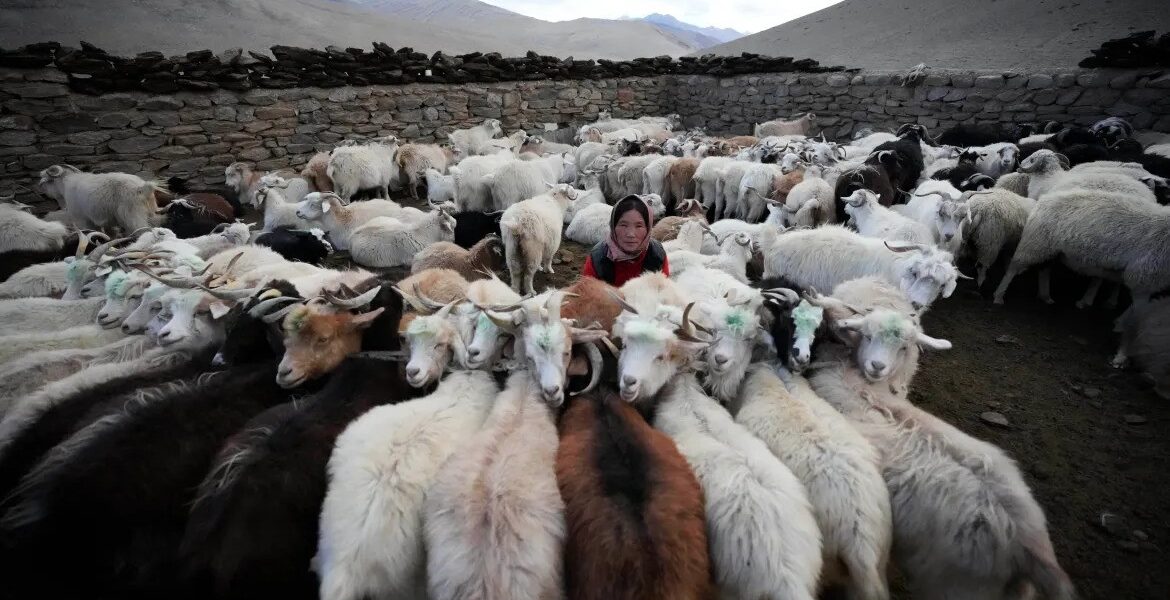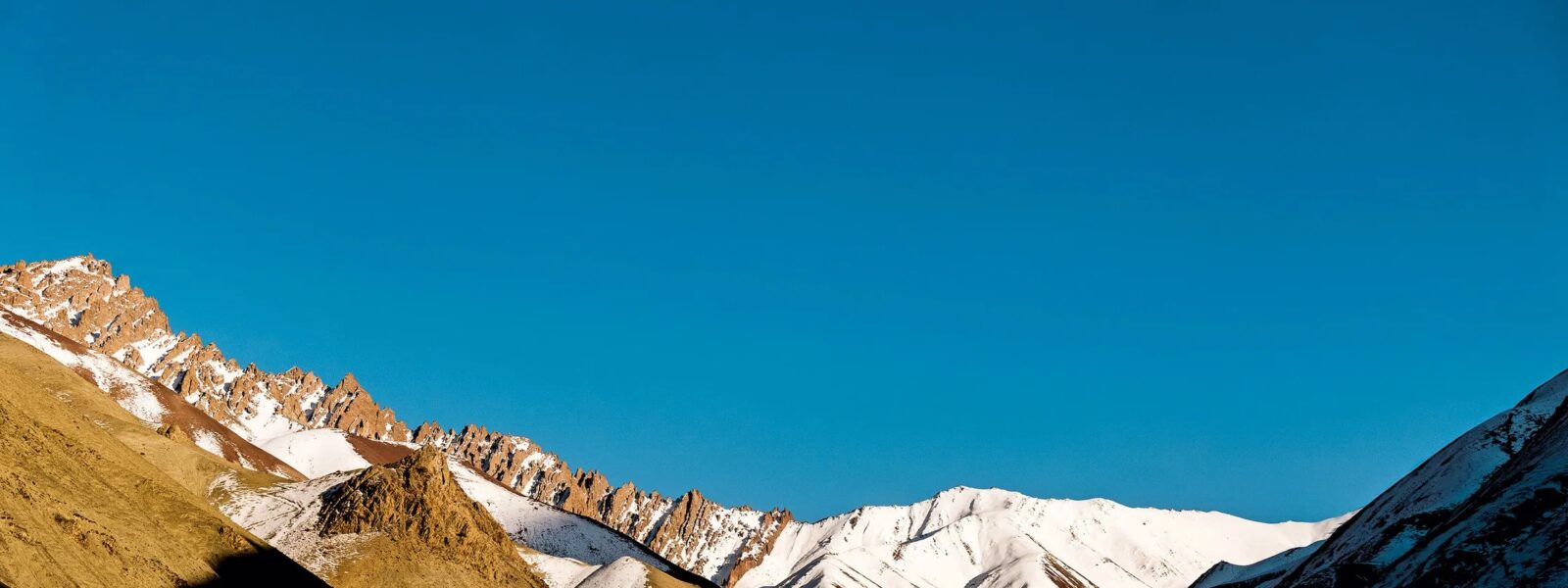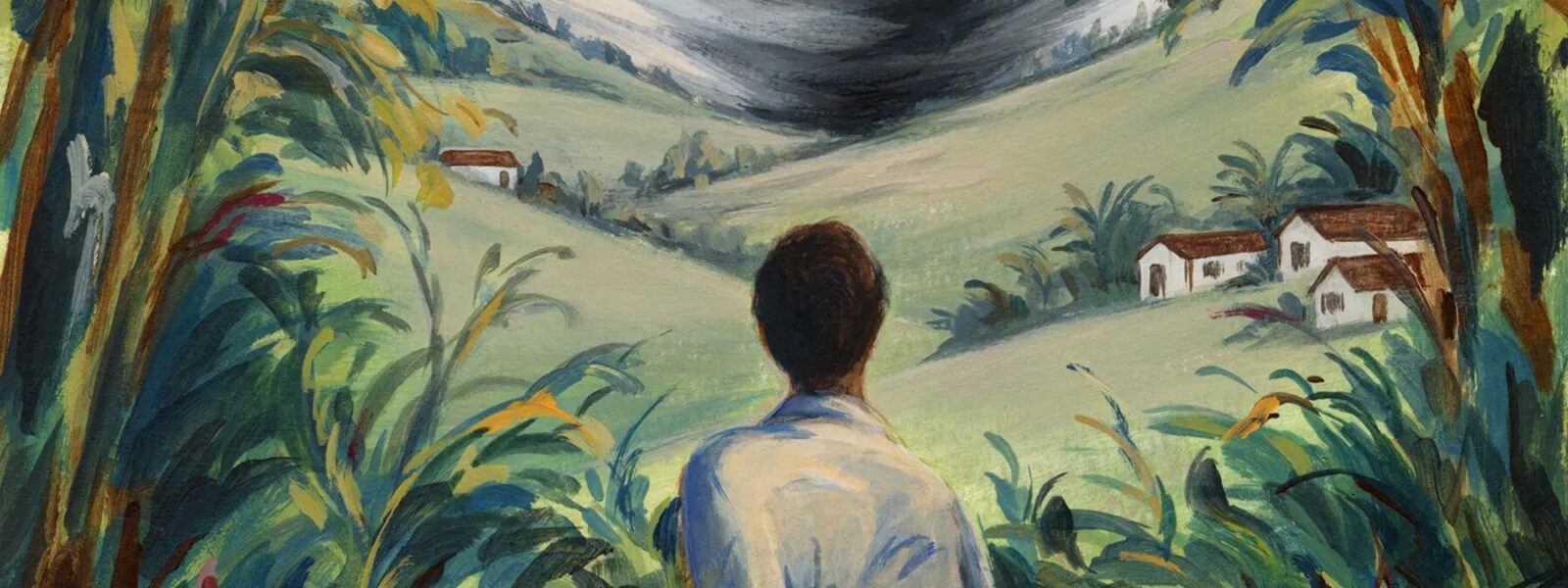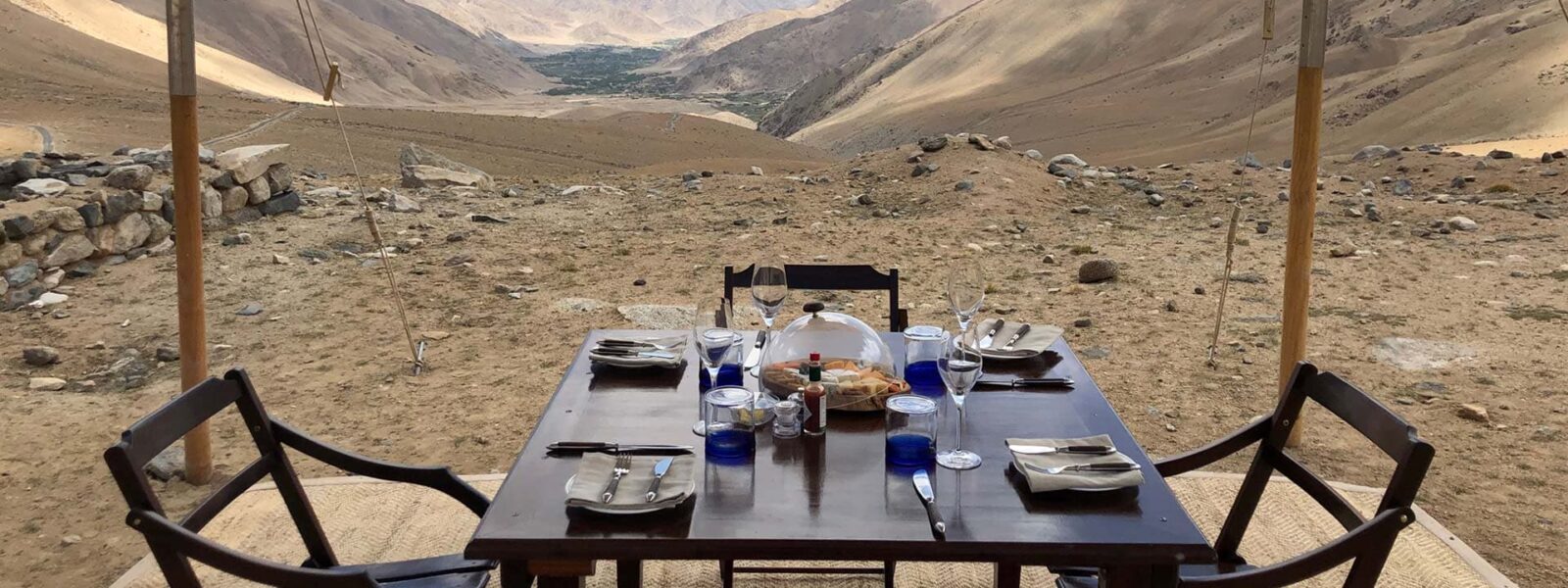The Call of the High Himalayas: A Journey Begins
The wind at 5,000 meters is a different kind of wind. It doesn’t simply push against you—it carves through you, stripping away everything unessential. In Ladakh, at the rooftop of the world, you are forced to meet yourself. There are no lush green canopies like the Inca Trail, no bustling teahouses like the Everest Base Camp route. Instead, there is an austere silence, broken only by the rhythmic crunch of boots against dust, the distant whistle of a Himalayan eagle, and the flutter of prayer flags at a forgotten mountain pass.
This is not trekking in the Alps, nor the high plateaus of Patagonia. Ladakh is something else entirely. A world of bare-bone beauty, where the trails carve through forgotten monasteries, jagged cliffs, and Martian-like landscapes that feel more dream than reality. It is a place that forces comparison yet stands apart.
I first set foot in Ladakh over a decade ago, my mind cluttered with comparisons to other treks I had conquered—Torres del Paine in Chile, the Dolomites, even the revered routes of the Annapurna Circuit. But within days, Ladakh rewrote the script. Gone were the tourist-heavy checkpoints and guided expeditions where solitude was a luxury. Here, the mountains felt untamed, the land untouched. You could walk for miles without seeing another soul, your only companions the distant peaks, the slow-moving yaks, and the occasional monk on his way to a monastery older than most recorded histories.
In the village of Hemis Shukpachan, I met an old man who had never left Ladakh. He spoke of the mountains as if they were living beings, shifting in spirit as much as in form. “The world’s mountains speak different languages,” he told me over a bowl of butter tea, steam curling into the thin air. “But here in Ladakh, they whisper only to those who are willing to listen.”
That was the moment I understood. Ladakh isn’t a trek—it’s a pilgrimage. A journey where every pass crossed is less about distance covered and more about an evolution within. It is not about reaching a summit, but about standing still and letting the world unfold around you. In the coming sections, I will take you through the trails that redefine adventure itself—where Ladakh stands against the world’s greatest treks and why it may just be the best-kept secret in high-altitude trekking.
Ladakh vs. The World’s Most Iconic Treks
Trekking, at its core, is a test of endurance, will, and perspective. The routes that have earned legendary status—Everest Base Camp, Patagonia’s Torres del Paine, the Annapurna Circuit, and Kilimanjaro’s Machame Route—each offer their own brand of wonder. But how does Ladakh, a place often overlooked on the global trekking stage, compare to these giants?
To answer that, we must break down the essence of trekking itself. Is it about the highest altitude reached? The most photogenic landscapes? The challenge of isolation? Or is it something less tangible—an experience that lingers in the mind long after the last step is taken? If it is the latter, then Ladakh deserves to be more than a footnote in the world’s greatest trails. It demands center stage.
Markha Valley vs. The Annapurna Circuit
The Annapurna Circuit in Nepal is often considered the gold standard of Himalayan trekking. It winds through subtropical forests, terraced fields, and Tibetan-influenced villages before ascending into the barren alpine terrain of Thorong La Pass (5,416m). For decades, it has been the ultimate introduction to high-altitude trekking.
Now, compare that to Ladakh’s Markha Valley Trek. Here, you will find no lush forests or cascading waterfalls—only a raw, otherworldly landscape of towering canyons, ancient monasteries, and prayer flag-draped passes. Instead of bustling teahouses, you stay in remote homestays, sharing meals with Ladakhi families who have lived in these valleys for generations. Instead of crowded trails, you walk for hours without seeing another human being. And while the Annapurna Circuit has become increasingly commercialized, Markha Valley remains untouched, a relic of a Himalayan past that is fading elsewhere.
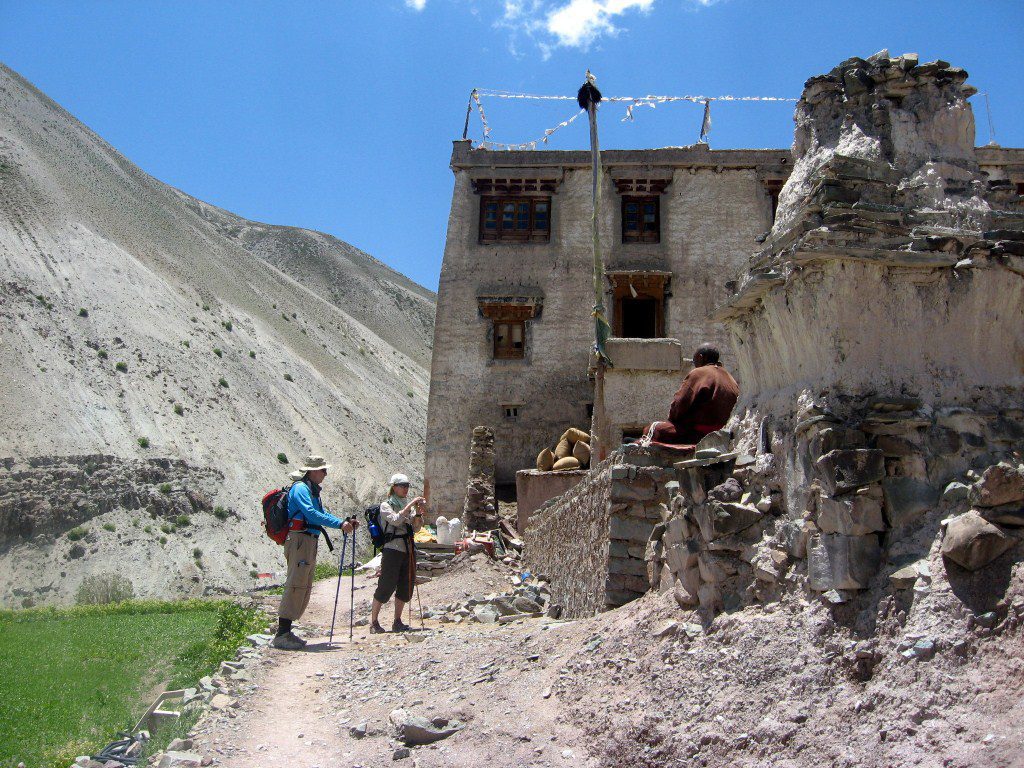
Chadar Trek vs. Canada’s Icefields Parkway
For those who chase winter extremes, the Chadar Trek in Ladakh is a rite of passage. This frozen river trek follows the Zanskar River as it solidifies into a sheet of ice each winter, forming an ephemeral pathway through the canyon walls. The experience is surreal—walking on ice that creaks beneath your boots, camping in caves along the riverbanks, and braving temperatures that plummet to -30°C (-22°F).
A natural comparison might be Canada’s Icefields Parkway, where frozen landscapes and glacial valleys stretch across the Rockies. But unlike a well-maintained road flanked by heated lodges, the Chadar Trek is a battle against nature itself. There is no room for error, no safety net. Here, the river dictates the terms—some years, the ice refuses to freeze properly, forcing trekkers to turn back. It is an experience where survival and adventure are intertwined, and it is precisely this unpredictability that makes it one of the most extreme winter treks on Earth.
Kang Yatse II vs. Kilimanjaro
Every trekker dreams of summiting a peak, and for many, Kilimanjaro is the first name that comes to mind. The highest mountain in Africa (5,895m), its well-established trekking routes make it a bucket-list climb. However, Ladakh offers its own contender: Kang Yatse II (6,250m).
While Kilimanjaro’s summit can be reached via non-technical trekking routes, Kang Yatse II presents an additional challenge. At over 6,000m, it requires basic mountaineering skills, including the use of crampons and ropes. Yet, the rewards are unparalleled. From the summit, the entire Zanskar range unfolds beneath you, a sea of snow-capped peaks stretching into Tibet and Pakistan. Unlike Kilimanjaro, where climbers ascend in guided groups of dozens, Kang Yatse remains largely untraveled, offering an intimacy with the mountains that is nearly impossible to find elsewhere.
Everest vs. Ladakh: Where Do You Find True Solitude?
To trek in Nepal is to walk in the shadows of legends. The Everest Base Camp (EBC) Trek is iconic, a pilgrimage to the foot of the world’s tallest mountain. But with its fame comes a cost—EBC is now one of the most crowded trekking routes on Earth, with thousands of trekkers sharing the trail each season.
Ladakh offers something different. Here, even on the most well-known trails, you may find yourself alone for hours, the silence interrupted only by the distant chime of yak bells or the chanting of monks in a nearby monastery. It is the kind of solitude that forces reflection, a stark contrast to the Everest trail, where long lines form at teahouse doorsteps, and the hum of helicopters fills the valleys below.
The Verdict: A Different Kind of Trekking Greatness
If trekking were simply about ticking off names—Everest, Kilimanjaro, Annapurna—then Ladakh might not make the cut. It lacks the branding of Nepal, the infrastructure of Patagonia, and the instant name recognition of the Alps. But for those who measure a trek by the depth of its experience rather than its marketing appeal, Ladakh might just be the greatest trekking destination on Earth.
In the next section, we will journey deeper into Ladakh’s cultural trekking routes, where ancient monasteries, Silk Road whispers, and lost mountain villages redefine what it means to walk through history.
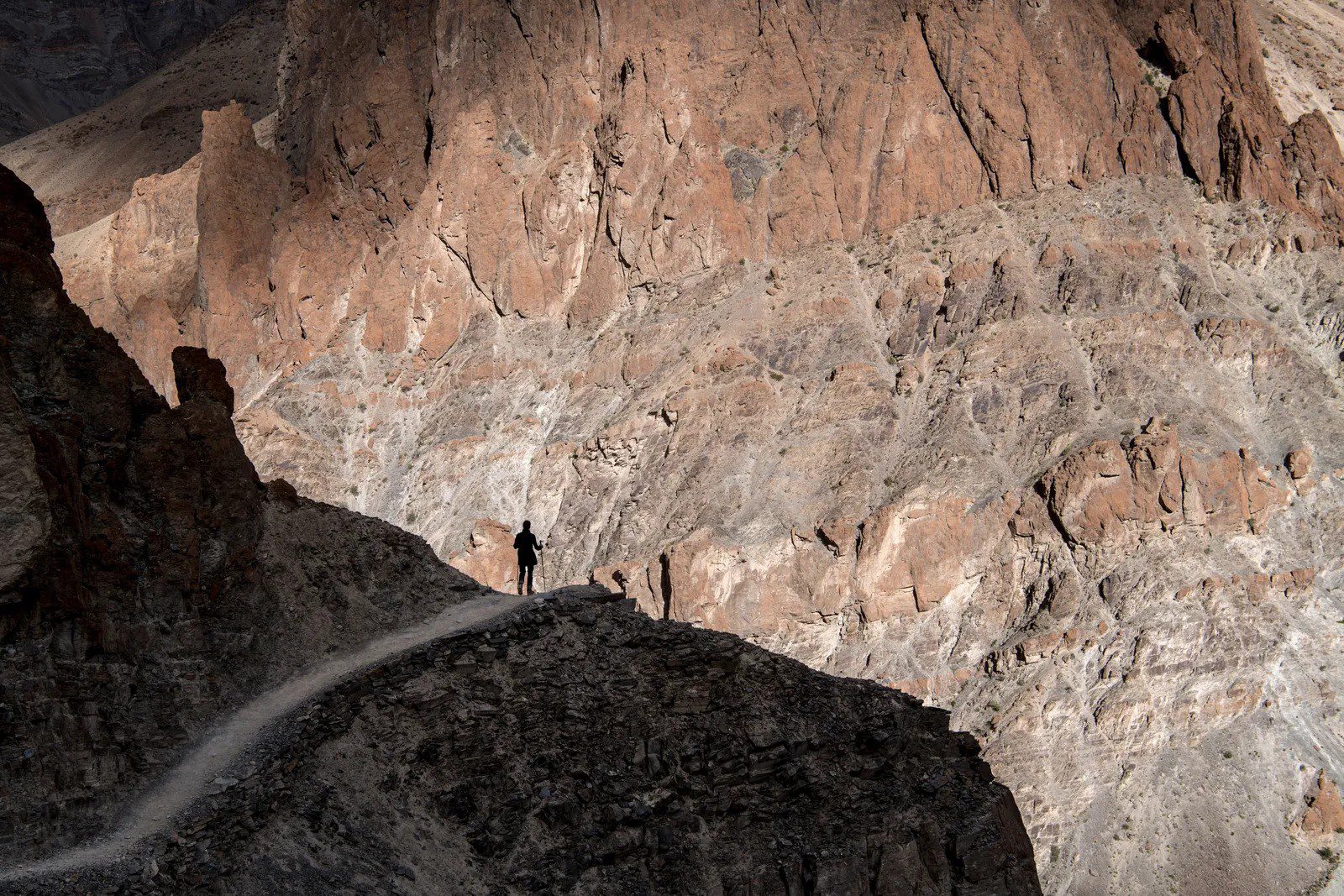
A Trek Through Time: Monasteries, Villages, and Silk Road Echoes
In Ladakh, trekking is not just a journey through landscapes; it is a walk through time. The trails here are older than modern nations, older than recorded history. They are the lifelines that once connected the Silk Road to the Buddhist kingdoms of the Himalayas. Every pass crossed, every valley descended, carries the footprints of traders, monks, and nomads who shaped the identity of this high-altitude desert.
Unlike the Alps or the Rocky Mountains, where trekking is primarily about summiting peaks and conquering trails, Ladakh offers something else: a pilgrimage through an ancient civilization. Here, the journey is as much about the people as it is about the mountains. The villages you pass through are not just rest stops; they are living museums, where traditions that have disappeared elsewhere remain intact.
Monasteries Older Than Time
On the Markha Valley Trek, as the barren landscape unfolds, a golden rooftop glimmers in the distance. This is Hemis Monastery, Ladakh’s largest and most famous Buddhist monastery, built in 1672. Inside, monks in deep red robes chant age-old prayers, their voices blending with the hum of the wind outside.
Further along, in the remote Zanskar region, the trek to Phugtal Monastery feels like a step into the past. Carved into a cliffside, it clings to the mountain as if suspended between heaven and earth. Here, life has changed little over the centuries. The monastery is accessible only by foot, and the isolation is deliberate—this is a place for those seeking silence, wisdom, and enlightenment.
Compare this to the famous trekking routes of Nepal, where Everest trails are lined with teahouses and bustling tourist hubs. Ladakh’s monasteries remain untouched, their solitude unbroken. They are places where trekking becomes more than physical endurance—it becomes a spiritual experience.
Nomadic Villages and the Vanishing Way of Life
Unlike the structured villages of the Swiss Alps or the organized rest stations of Japan’s Kumano Kodo, Ladakh’s settlements remain wild and uncurated. The trek through Changthang, the high-altitude plateau near Tso Moriri, reveals a landscape dotted with black tents—home to the nomadic Changpa people. They have lived here for generations, herding pashmina goats and moving with the seasons.
Further west, along the trail to Hundar Dok, ancient stone houses cling to the valley, their walls blackened by centuries of butter-lamp smoke. Here, life moves to a different rhythm—fields of barley sway in the wind, children with sunburned cheeks chase each other along narrow alleyways, and elders sit outside, spinning prayer wheels and whispering stories of the past.
In a world where modernization is erasing traditional ways of life, Ladakh remains an outlier. The villages are not relics—they are homes, lived in and loved, their people as much a part of the landscape as the mountains themselves.
The Silk Road Connection: Walking in the Footsteps of Traders
Trekking in Ladakh is not just about reaching high passes; it is about tracing the routes of ancient traders who once carried silk, spices, and turquoise across these mountains. The Lamayuru to Chilling trek follows one of the oldest trade routes in the Himalayas, a path that once connected India to Tibet and Central Asia.
At the village of Alchi, a short detour from the trail reveals a monastery adorned with frescoes from the 11th century—paintings that tell stories of a time when Ladakh was a thriving center of commerce and culture. The influence of Persia, China, and India is visible in the intricate details, a reminder that Ladakh was once a vital crossroads between worlds.
Today, these routes have faded into obscurity, replaced by modern highways and border tensions that have severed the old connections. But for trekkers willing to walk these forgotten paths, the echoes of the Silk Road still whisper in the wind.
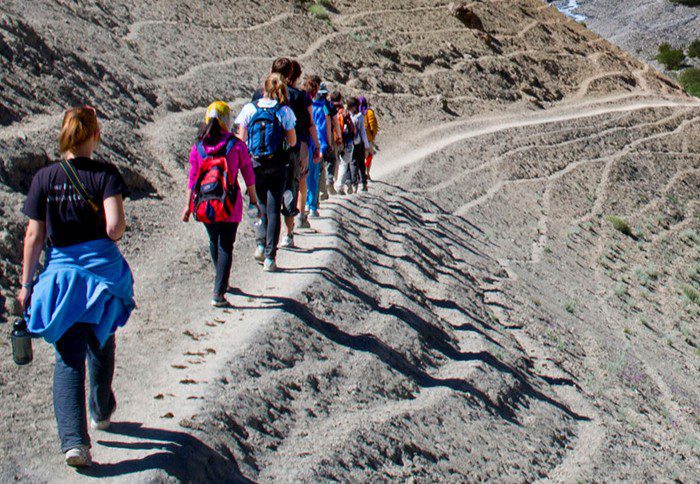
Why Ladakh is More Than Just a Trek
Every great trekking destination has its allure—Nepal offers the thrill of Everest, Patagonia delivers raw natural beauty, and the Camino de Santiago is steeped in history. But Ladakh is different. It is not just a trek; it is an immersion into a world that still holds secrets. It is a chance to step into the past, to walk alongside history, to connect with a way of life that is rapidly vanishing.
For those who seek more than just a trail to conquer, for those who long to understand the soul of a place rather than simply pass through it—Ladakh offers something rare: a journey that transcends time.
In the next section, we will explore Ladakh’s breathtaking landscapes, from the surreal dunes of Nubra Valley to the turquoise waters of Tso Moriri—proving that no other trek on Earth offers this diversity.
The Landscape That Defies Comparison
Trekking in Ladakh is not just about distance covered or altitude gained—it is about walking through a landscape that seems borrowed from another world. Here, the trails cut across vast moonscapes, along the edges of turquoise lakes, and into valleys so remote they feel untouched by time. Unlike the dense forests of the Everest Base Camp trek or the lush greenery of the Swiss Alps, Ladakh’s terrain is unapologetically stark. Yet, in its austerity lies its greatest beauty.
No two trekking routes in Ladakh are the same. The diversity is staggering—from the wind-sculpted dunes of Nubra Valley to the mirror-like reflections of Tso Moriri. This is a land where the Himalayas meet the Tibetan Plateau, where glaciers feed rivers that carve their way through gorges that seem bottomless. It is a place that challenges our perception of what a high-altitude desert can be.
Beyond the Desert: The Living Dunes of Nubra Valley
The term “desert” conjures images of lifeless sandscapes, but Nubra Valley shatters this stereotype. Situated north of Leh, this valley is home to Hunder’s famous sand dunes, a phenomenon rarely found at such high altitudes. Golden dunes ripple against the backdrop of snow-clad peaks, a visual paradox that makes it one of the most surreal trekking experiences on Earth.
Trekking through Nubra means tracing ancient caravan routes once traveled by traders on the Silk Road. It means walking alongside the double-humped Bactrian camels, descendants of those that once carried goods between Central Asia and India. It means camping beneath a sky so clear that the Milky Way seems almost within reach.
Few trekking destinations in the world offer this kind of contrast—the Sahara may have dunes, and the Himalayas may have peaks, but where else do they meet so dramatically?

Tso Moriri: The Lake That Changes Color
Further east, Ladakh unveils another marvel—Tso Moriri, a high-altitude lake that shimmers in shades of turquoise, emerald, and sapphire depending on the light. At 4,522 meters, it is one of the highest lakes in the world, its waters fed by glacial melt and seasonal snowmelt.
Unlike Nepal’s crowded Gokyo Lakes trek or the famous Lake Louise in Canada, Tso Moriri remains a hidden gem, largely untouched by tourism. The surrounding landscape is equally breathtaking—rolling meadows where Kiangs (wild Tibetan donkeys) roam freely, rugged cliffs where golden eagles soar, and nomadic settlements where the Changpa people still herd their Pashmina goats, as they have for centuries.
For trekkers, Tso Moriri is not just a destination—it is a meditation in motion. To walk along its shores at sunrise, watching the first light paint the lake in gold and crimson, is to witness nature at its most poetic.
The Hidden Kingdom of Zanskar
To the southwest of Ladakh lies Zanskar, a landlocked kingdom encased by mountains so formidable that it is cut off from the rest of the world for nearly half the year. The trekking routes here are among the most demanding yet rewarding in the Himalayas.
In summer, the Zanskar Valley Trek takes adventurers through villages where ancient Buddhist traditions remain untouched. Monasteries like Karsha and Phugtal, perched on sheer cliffs, stand as testaments to a time when isolation was a form of spiritual discipline.
In winter, when temperatures plummet to -30°C, the region transforms into a frozen kingdom, giving rise to the legendary Chadar Trek—a route where trekkers walk across the frozen Zanskar River, navigating a world of ice caves and frozen waterfalls. It is a landscape that feels otherworldly, a place where time slows down and survival depends on the whims of nature.
Why Ladakh’s Landscape Stands Apart
Every great trekking destination has a defining feature—Nepal has its towering peaks, Patagonia its glaciers, and the Alps their green valleys—but Ladakh refuses to be categorized. It is a place where the Himalayas meet the desert, where high-altitude lakes mirror the sky, and where silence speaks louder than words.
To trek in Ladakh is to experience a planet within a planet. Every trail tells a different story, every pass crossed feels like a gateway to another realm. For those who seek a trek that is more than just a journey, for those who crave landscapes that defy comparison—Ladakh offers a stage like no other.
In the next section, we will explore the challenges and triumphs of high-altitude trekking in Ladakh, from battling altitude sickness to the mental endurance required to push beyond one’s limits.
Altitude, Endurance, and the Human Spirit
Trekking in Ladakh is not for the faint-hearted. This is not a leisurely stroll through the Swiss Alps or a well-marked path on the Camino de Santiago. Ladakh’s trails are wild, untamed, and at times, unforgiving. But that is precisely what makes them unforgettable. Here, every step is an act of defiance against gravity, against thin air, against the limits of human endurance.
At an altitude where oxygen is scarce, the body rebels. Breathing becomes labored, muscles ache faster, and every incline feels steeper than it should. Ladakh teaches a lesson that few other trekking destinations can: this is not just about strength; it is about adaptation. And in that adaptation lies the true test of the human spirit.

The Battle Against Altitude
Ask any seasoned trekker, and they will tell you—altitude is the great equalizer. It does not matter how fit you are or how many summits you have conquered; above 4,500 meters, the rules change. Ladakh’s trekking routes often begin at elevations that would already be considered high-altitude elsewhere.
Take, for instance, the legendary Kongmaru La Pass (5,260m) on the Markha Valley Trek. The ascent is slow and deliberate, the path zigzagging up a barren mountainside where the wind cuts like a blade. Every step is measured, controlled. Push too fast, and the effects of altitude sickness—dizziness, nausea, splitting headaches—can hit without warning.
For those attempting the Kang Yatse II (6,250m) summit, the challenge is even greater. Here, altitude is not just an obstacle—it is a living force, dictating who makes it to the top and who is forced to turn back. The air at this height holds only about half the oxygen found at sea level. The heart pounds harder, the lungs work overtime, and each step feels like wading through deep water.
The Psychology of Endurance
Physical strength will only take you so far. At high altitudes, the mind becomes the most critical muscle. The greatest battles are fought internally—against self-doubt, against exhaustion, against the instinct to quit.
On the Chadar Trek, where trekkers walk for days on a frozen river in temperatures as low as -30°C (-22°F), mental resilience is everything. There are no shortcuts, no easy way out. Each day is a test of patience and willpower. The ice beneath your feet shifts unpredictably, sometimes cracking, sometimes melting into open water. Every night, you sleep in caves, the sound of the river flowing beneath the ice a constant reminder that nature is in control.
In Ladakh, the trails are long, the terrain unyielding, and the solitude immense. But it is in this solitude that clarity is found. It strips away the unnecessary, leaving only the raw essentials—breath, movement, survival.
Lessons from the High Himalayas
Ladakh does not offer the comforts of well-trodden routes in Nepal or the hospitality of Alpine lodges. There are no luxury retreats, no easy escape routes. And yet, those who endure its challenges emerge transformed.
Trekking in Ladakh teaches humility. The mountains do not care about your ambitions, your personal records, or your past conquests. They will humble even the most experienced trekkers. They demand respect and patience. Those who listen, who adapt, who embrace the slow rhythm of high-altitude trekking—these are the ones who succeed.
The reward? A moment that cannot be measured in distance or elevation. A sunrise at 6,000 meters, where the first light touches the Himalayan peaks in a glow so golden it feels unreal. A silence so profound it becomes a sound in itself. A realization that in this extreme environment, stripped of all distractions, you have found something rare: a glimpse of your true self.
The Ultimate Challenge, The Ultimate Reward
To trek in Ladakh is to step beyond comfort, beyond routine, beyond the familiar. It is to venture into a world where survival depends on adaptation, where endurance is measured in patience, and where the mountains offer no guarantees—only the chance to prove to yourself that you are capable of more than you ever imagined.
For those who seek more than just another trekking destination, for those who crave not just a physical challenge but a transformation, Ladakh stands alone. It is not simply a place to visit—it is a place to be tested, to be humbled, to be reborn.
In the next section, we will examine the impact of trekking on Ladakh’s fragile ecosystem and the efforts to promote sustainable, responsible trekking in the Himalayas.
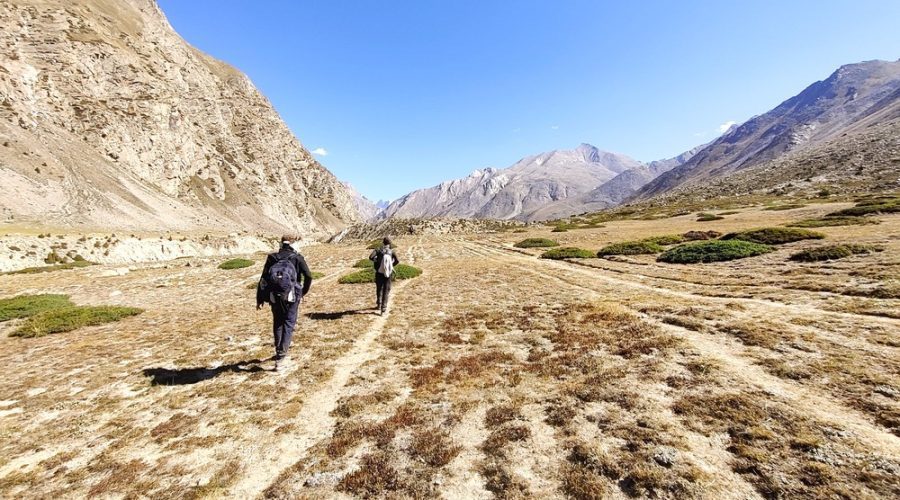
Sustainable Trekking: Can Ladakh Stay Untouched?
Ladakh has always been a land of resilience. For centuries, its people have survived in one of the harshest environments on Earth, mastering the delicate balance between nature and survival. But in the past decade, a new challenge has emerged—one that no ancient wisdom can fully prepare for: the impact of modern tourism.
As Ladakh rises in global trekking circles, drawing adventurers from Nepal, Europe, and beyond, the same question lingers—can it remain untouched? Can this high-altitude desert sustain the weight of mass tourism without losing the very essence that makes it special?
The Cost of Popularity
It is an irony seen across the world’s most beautiful places—popularity becomes their greatest threat. The Everest region of Nepal has faced this for years, with trails clogged by thousands of trekkers, trash piling up at base camps, and fragile ecosystems struggling under the weight of demand.
Ladakh, for now, remains relatively pristine. But cracks are beginning to show. The once-isolated villages along the Markha Valley Trek are experiencing a surge in foot traffic. The Chadar Trek, once known for its near-mythical isolation, is now at risk due to both climate change and overtourism. The frozen river that made the trek famous is no longer guaranteed to freeze, and human activity along the route accelerates its fragility.
Even the high-altitude lakes of Pangong and Tso Moriri are seeing an increase in visitors who bring plastic waste but take nothing of Ladakh’s deep-rooted sustainability traditions.
Lessons from the Alps, Nepal, and Patagonia
Other trekking regions have faced similar crises. The Swiss Alps, despite their legendary beauty, are now dominated by ski resorts and paved access roads. The Annapurna Circuit, once considered Nepal’s finest trek, has seen its landscape altered by roads that now allow motorbikes and jeeps to reach once-remote villages.
Patagonia, however, offers a glimmer of hope. Strict visitor limits in Torres del Paine National Park have helped preserve its wilderness, proving that sustainable tourism policies can work—if implemented in time.
Can Ladakh Follow a Different Path?
Ladakh’s strength lies in its traditions. For generations, Ladakhis have practiced a form of natural sustainability that modern conservationists could learn from. The region’s traditional mud-brick architecture, reliance on solar energy, and rotational grazing practices in pastoral communities are all models of low-impact living.
If Ladakh is to protect its trails from overuse, it must act now. Limiting numbers on fragile routes, ensuring homestays and trekking agencies follow leave-no-trace ethics, and promoting eco-conscious trekking groups are essential steps.
Perhaps the most critical factor is education. Trekkers who arrive in Ladakh must understand that this is not a place to be “conquered” but a place to be respected. Every footprint left behind alters a landscape that has remained largely unchanged for millennia.
How You Can Trek Responsibly in Ladakh
For those planning to trek in Ladakh, here are a few simple but powerful ways to minimize your impact:
- 1. Choose Homestays Over Camps: Staying in village homes rather than setting up camps reduces environmental impact and supports the local economy.
- 2. Carry Your Waste: There are no garbage disposal facilities at high altitude—what you bring in, you must bring out.
- 3. Respect Water Sources: Avoid washing with soap in rivers or lakes. Ladakh’s water supply is fragile and sacred.
- 4. Say No to Plastic: Bring reusable water bottles and purification tablets instead of buying plastic bottles along the trail.
- 5. Support Sustainable Trekking Agencies: Choose guides and agencies that actively promote conservation.
Preserving Ladakh for the Future
Trekking in Ladakh is an experience unlike any other. It offers a chance to step back in time, to walk in the footsteps of traders, monks, and nomads who understood the land better than we ever could. But if we wish to keep it that way, we must rethink the way we travel.
Ladakh is not just another trekking destination; it is a living landscape, a fragile yet resilient world that needs protection. The responsibility does not lie with governments or organizations alone—it lies with every trekker who sets foot on these trails.
The question remains: will we leave Ladakh as we found it? Or will we leave behind a trail of irreversible change?
In the next and final section, we will reflect on Ladakh’s place among the world’s greatest trekking destinations and answer the ultimate question—is Ladakh the last true trekking paradise?
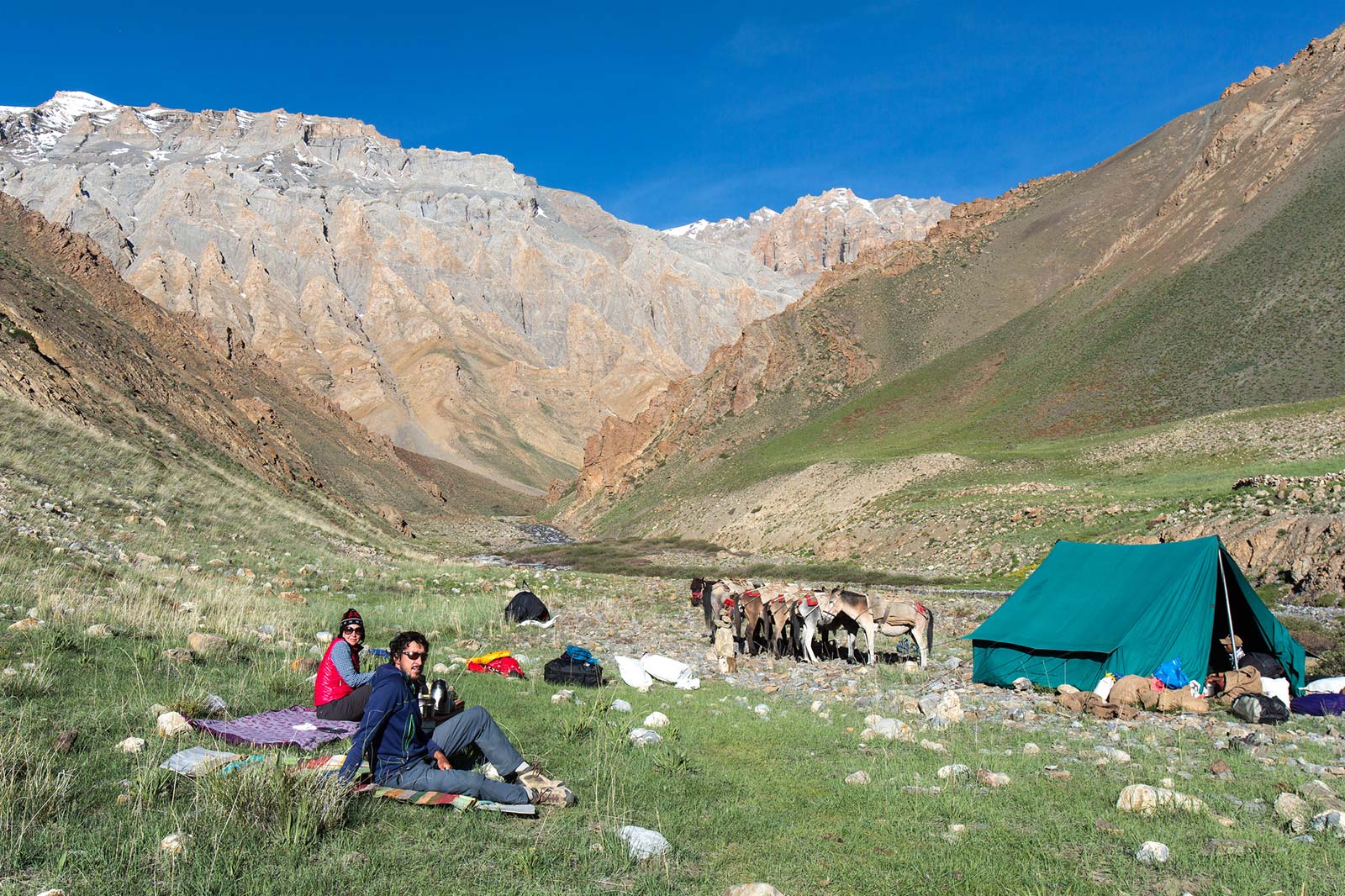
The Verdict: Where Does Ladakh Stand?
There are trekking destinations that are famous, and then there are those that leave an imprint on the soul. Everest Base Camp dazzles with its legendary reputation. The Inca Trail offers a journey through ancient history. The Alps impress with their picture-perfect landscapes. But Ladakh is something else entirely—it does not fit into a simple category. It is not just about altitude or scenery. It is about solitude, endurance, culture, and connection. It is about walking in a place where time bends, where history lingers in the mountain air, where silence speaks louder than words.
So where does Ladakh stand among the world’s greatest treks? The answer depends on what a trekker seeks.
If You Seek Challenge and Endurance
Ladakh is relentless. There are no gentle acclimatization days like in Nepal. Trekkers often begin their journey at elevations higher than many Alpine summits. Routes like the Chadar Trek and Kang Yatse II demand resilience, where survival depends on how well you adapt to extreme cold, thin air, and unpredictable terrain.
Compared to Patagonia or the Rockies, Ladakh’s treks are harsher, more rugged, and less forgiving. But for those who thrive on pushing their limits, there is no greater test.
If You Seek Cultural Immersion
Unlike the bustling trekking hubs of Everest or Annapurna, Ladakh remains authentic. The villages you pass through are not commercialized. The monasteries are not crowded tourist attractions; they are still functioning centers of Buddhist life. Here, you share meals with Ladakhi families in mud-brick homes, sleep under roofs blackened by centuries of butter-lamp smoke, and walk trails that monks have used for generations.
If cultural depth matters more than just scenery, Ladakh has few rivals.
If You Seek Solitude
In Nepal, even the most remote treks have teahouses and company. In the Alps, you are never far from civilization. But in Ladakh, you can walk for entire days without seeing another soul. The silence here is not just an absence of noise; it is a presence in itself. It is something you feel, something that shifts the way you perceive time.
For those who wish to escape—not just from the modern world, but from the need for distraction—Ladakh is a rare gift.
So, Is Ladakh the Last True Trekking Paradise?
The term “last great trekking destination” has been applied to many places, often right before mass tourism changes them forever. Ladakh still holds that title—for now. But for how long?
The next decade will decide Ladakh’s fate. Will it follow the path of Nepal’s over-commercialized routes, or will it preserve its wild heart? The answer lies in how trekkers, guides, and policymakers choose to move forward. The responsibility is shared by all who set foot here.
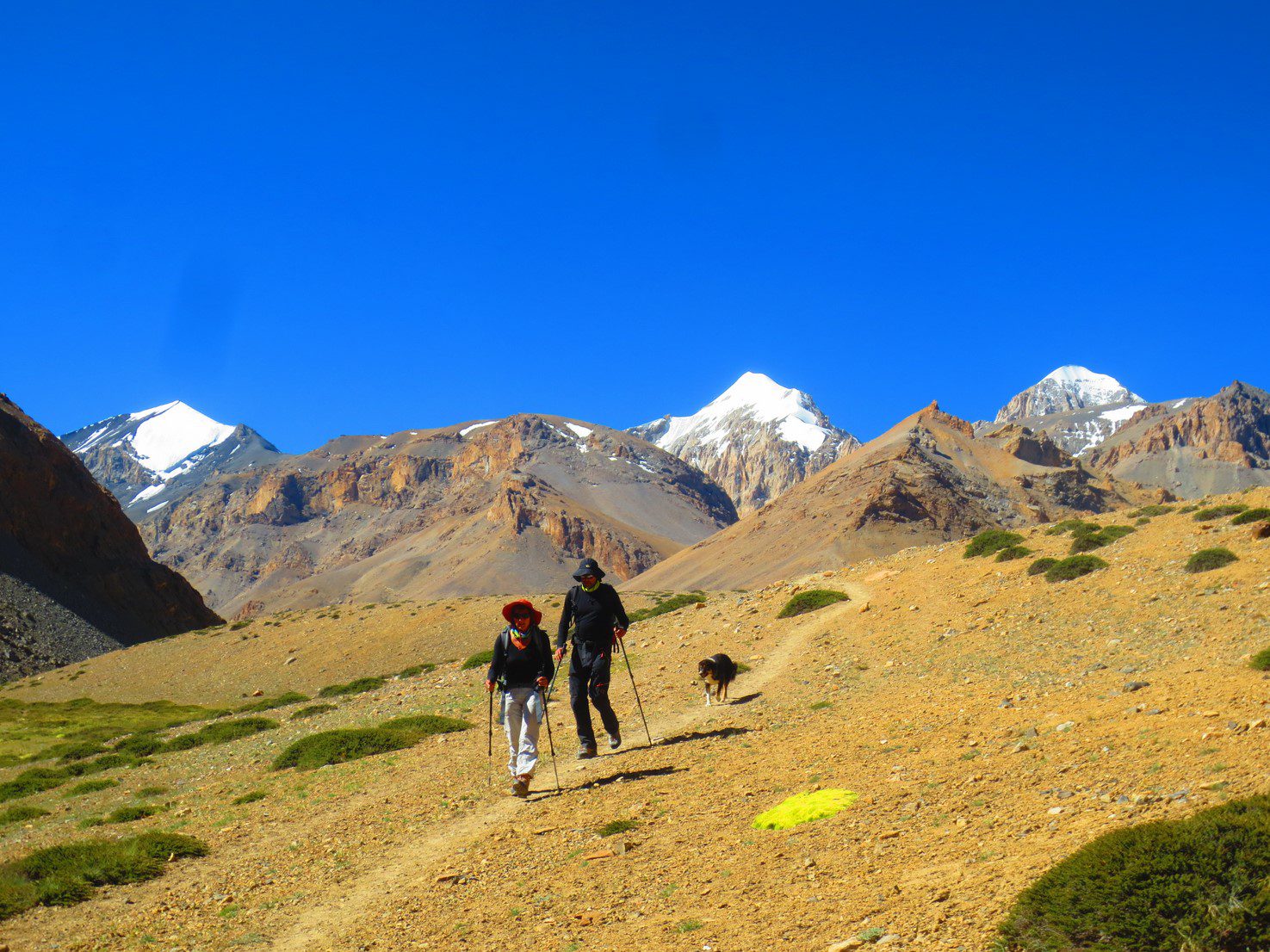
The Final Thought: Why Ladakh is More Than Just a Trek
There is a reason why Ladakh stays with those who walk its trails. It is not just the landscapes—though they are unforgettable. It is not just the altitude—though it is brutal. It is something deeper.
It is the knowledge that in a world growing smaller, where adventure is increasingly tamed, there is still a place that demands something from you. A place that does not bend to comfort. A place where you must surrender to the mountains and, in return, they reveal something rare: a glimpse of the world before it was mapped, before it was conquered—before it was known.
For those who seek the world’s greatest treks, Ladakh does not need to compete. It redefines what trekking means.
Ladakh is not a place you visit. It is a place that stays with you long after you leave.
Declan P. O’Connor is a travel writer and columnist specializing in high-altitude trekking, cultural expeditions, and remote landscapes. His work explores the intersection of adventure and human endurance, capturing the world’s last great trekking frontiers. When not on the trail, he can be found writing from a quiet corner of the Himalayas.


